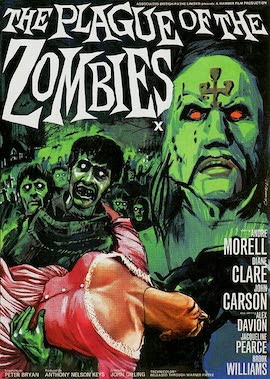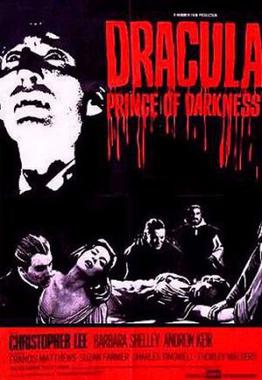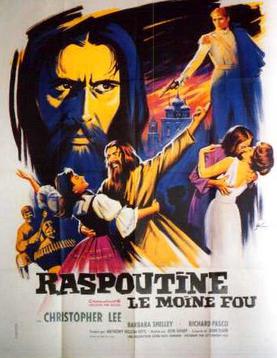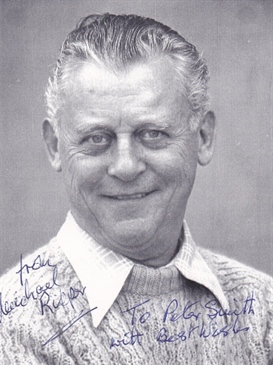Hammer Film Productions Ltd. is a British film production company based in London. Founded in 1934, the company is best known for a series of Gothic horror and fantasy films made from the mid-1950s until the 1970s. Many of these involve classic horror characters such as Baron Victor Frankenstein, Count Dracula, and the Mummy, which Hammer reintroduced to audiences by filming them in vivid colour for the first time. Hammer also produced science fiction, thrillers, film noir and comedies, as well as, in later years, television series.

Dracula is a 1958 British gothic horror film directed by Terence Fisher and written by Jimmy Sangster based on Bram Stoker's 1897 novel of the same name. The first in the series of Hammer Horror films starring Christopher Lee as Count Dracula, the film also features Peter Cushing as Doctor Van Helsing, along with Michael Gough, Melissa Stribling, Carol Marsh, and John Van Eyssen. In the United States, the film was retitled Horror of Dracula to avoid confusion with the U.S. original by Universal Pictures, 1931's Dracula.

Jacqueline Pearce was a British film and television actress. She was best known for her portrayal of the principal villain Servalan in the British science fiction TV series Blake's 7 (1978–1981), a performance which her obituarist in The Times wrote produced "a sexual awakening for a generation of sci-fi fans".

The Curse of Frankenstein is a 1957 British horror film by Hammer Film Productions, loosely based on the 1818 novel Frankenstein; or, The Modern Prometheus by Mary Shelley. It was Hammer's first colour horror film, and the first of their Frankenstein series. Its worldwide success led to several sequels, and it was also followed by new versions of Dracula (1958) and The Mummy (1959), establishing "Hammer Horror" as a distinctive brand of Gothic cinema.

The Plague of the Zombies is a 1966 British horror film directed by John Gilling and starring André Morell, John Carson, Jacqueline Pearce, Brook Williams, and Michael Ripper. The film's imagery influenced many later films in the zombie genre.

Dracula Has Risen from the Grave is a 1968 British supernatural horror film directed by Freddie Francis and produced by Hammer Film Productions. It is the fourth entry in Hammer's Dracula series, and the third to feature Christopher Lee as Count Dracula, the titular vampire. The film stars Rupert Davies as a clergyman who exorcises Dracula's castle, and in doing so, unwittingly resurrects the Count back from the dead.
James Michael Bernard was a British film composer, particularly associated with horror films produced by Hammer Film Productions. Beginning with The Quatermass Xperiment, he scored such films as The Curse of Frankenstein and Dracula. He also occasionally scored non-Hammer films including Windom's Way (1957) and Torture Garden (1967).

Dracula: Prince of Darkness is a 1966 British gothic supernatural horror film directed by Terence Fisher. The film was produced by Hammer Film Productions, and is the third entry in Hammer's Dracula series, as well as the second to feature Christopher Lee as Count Dracula, the titular vampire. It also stars Andrew Keir, Francis Matthews, and Barbara Shelley.

Barbara Shelley was an English film and television actress. She appeared in more than a hundred films and television series. She was particularly known for her work in horror films, notably Village of the Damned; Dracula, Prince of Darkness; Rasputin, the Mad Monk and Quatermass and the Pit.

Rasputin the Mad Monk is a 1966 Hammer horror film directed by Don Sharp and starring Christopher Lee as Grigori Rasputin, the Russian peasant-mystic who gained great influence with the Tsars prior to the Russian Revolution. It also features Barbara Shelley, Francis Matthews, Suzan Farmer, Richard Pasco, Dinsdale Landen and Renée Asherson. The story is largely fictionalized, although some of the events leading up to Rasputin's assassination are very loosely based on Prince Yusupov's account of the story. For legal reasons, the character of Yusupov was replaced by Ivan (Matthews).

Bray Film Studios is a British film and television facility in Water Oakley near Bray, Berkshire. It is best known for its association with Hammer Film Productions.

The Satanic Rites of Dracula is a 1973 British horror film directed by Alan Gibson and produced by Hammer Film Productions. It is the eighth film in Hammer's Dracula series, and the seventh and final one to feature Christopher Lee as Dracula. The film was also the third to unite Peter Cushing as Van Helsing with Lee, following Dracula (1958) and Dracula A.D. 1972 (1972).
Bernard Robinson designed sets for several of Hammer's films in their heyday, including The Curse of Frankenstein (1957), Abominable Snowman of the Himalayas (1957), Dracula (1958), Curse of the Werewolf (1960), The Phantom of the Opera (1962), The Gorgon (1964) and Quatermass and the Pit (1968). He was known for giving the Hammer films a lavish, expensive look while working on a restricted budget. The association ended with his premature death in 1970.

Seven Arts Productions was a production company which made films for release by other studios. It was founded in 1957 by Eliot Hyman, Ray Stark, and Norman Katz.

Taste the Blood of Dracula is a 1970 British supernatural horror film produced by Hammer Film Productions. Directed by Peter Sasdy from a script by Anthony Hinds, it is the fifth installment in Hammer's Dracula series, and the fourth to star Christopher Lee as Count Dracula, the titular vampire. The film also features Geoffrey Keen and Gwen Watford.

Michael George Ripper was an English character actor.

John Derek Carson-Parker, known as John Carson, was an English actor known for his appearances in film and television.
Sir James Enrique Carreras was a British film producer and executive who, together with William Hinds, founded the British company Hammer Film Productions. His career spanned nearly 45 years, in multiple facets of the entertainment industry until retiring in 1972.
The World of Hammer is a British television documentary series created and written by Robert Sidaway and Ashley Sidaway, and produced by Robert Sidaway.














